2020 Ram ProMaster City ECU
[x] Cancel search: ECUPage 111 of 350

108 SAFETY
OCCUPANT RESTRAINT SYSTEMS
Some of the most important safety features in your vehicle
are the restraint systems:
Occupant Restraint Systems
• Seat Belt Systems
• Supplemental Restraint Systems (SRS) Air Bags
• Child Restraints
Some of the safety features described in this section may be
standard equipment on some models, or may be optional
equipment on others. If you are not sure, ask an authorized
dealer.
Important Safety Precautions
Please pay close attention to the information in this section.
It tells you how to use your restraint system properly, to
keep you and your passengers as safe as possible.
Here are some simple steps you can take to minimize the risk
of harm from a deploying air bag:
1. Children 12 years old and under should always ridebuckled up in the rear seat of a vehicle with a rear seat. 2. A child who is not big enough to wear the vehicle seat belt
properly (Refer to “Child Restraints” in this section for
further information) must be secured in the appropriate
child restraint or belt-positioning booster seat in a rear
seating position.
3. If a child from 2 to 12 years old (not in a rear-facing child restraint) must ride in the front passenger seat, move the
seat as far back as possible and use the proper child
restraint (Refer to “Child Restraints” in this section for
further information).
4. Never allow children to slide the shoulder belt behind them or under their arm.
5. You should read the instructions provided with your child restraint to make sure that you are using it properly.
6. All occupants should always wear their lap and shoulder belts properly.
7. The driver and front passenger seats should be moved back as far as practical to allow the front air bags room to
inflate.
2020_RAM_PROMASTER_CITY_OM_USA=GUID-7B6A7FCA-79B0-423F-95C5-ED2A949C3D13=1=en=.book Page 108
Page 113 of 350

110 SAFETY
Initial Indication
If the driver is unbuckled when the ignition switch is first in the
AVV/START or MAR/RUN position, a chime will signal for a few
seconds. If the driver or outboard front seat passenger (if equipped
with outboard front passenger seat BeltAlert) is unbuckled when
the ignition switch is first in the AVV/START or MAR/RUN posi-
tion the Seat Belt Reminder Light will turn on and remain on until
both outboard front seat belts are buckled. The outboard front
passenger seat BeltAlert is not active when an outboard front
passenger seat is unoccupied.
BeltAlert Warning Sequence
The BeltAlert warning sequence is activated when the vehicle is
moving above a specified vehicle speed range and the driver or
outboard front seat passenger is unbuckled (if equipped with
outboard front passenger seat BeltAlert) (the outboard front
passenger seat BeltAlert is not active when the outboard front
passenger seat is unoccupied). The BeltAlert warning sequence
starts by blinking the Seat Belt Reminder Light and sounding an
intermittent chime. Once the BeltAlert warning sequence has
completed, the Seat Belt Reminder Light will remain on until the
seat belts are buckled. The BeltAlert warning sequence may repeat
based on vehicle speed until the driver and occupied outboard front
seat passenger seat belts are buckled. The driver should instruct all
occupants to buckle their seat belts.
Change of Status
If the driver or outboard front seat passenger (if equipped
with outboard front passenger seat BeltAlert) unbuckles
their seat belt while the vehicle is traveling, the BeltAlert
warning sequence will begin until the seat belts are buckled
again.
The outboard front passenger seat BeltAlert is not active
when the outboard front passenger seat is unoccupied.
BeltAlert may be triggered when an animal or other items are
placed on the outboard front passenger seat or when the seat
is folded flat (if equipped). It is recommended that pets be
restrained in the rear seat (if equipped) in pet harnesses or
pet carriers that are secured by seat belts, and cargo is prop
-
erly stowed.
BeltAlert can be activated or deactivated by an authorized
dealer. FCA US LLC does not recommend deactivating
BeltAlert.
NOTE:
If BeltAlert has been deactivated and the driver or outboard
front seat passenger (if equipped with outboard front
passenger seat BeltAlert) is unbuckled the Seat Belt
Reminder Light will turn on and remain on until the driver
and outboard front seat passenger seat belts are buckled.
2020_RAM_PROMASTER_CITY_OM_USA=GUID-7B6A7FCA-79B0-423F-95C5-ED2A949C3D13=1=en=.book Page 110
Page 121 of 350

118 SAFETY
Switchable Automatic Locking Retractors (ALR)
Vehicle Without Rear Seat
The seat belt in the passenger seating position is equipped
with a Switchable Automatic Locking Retractor (ALR) which
is used to secure a child restraint system. For additional
information, refer to “Installing Child Restraints Using The
Vehicle Seat Belt” under the “Child Restraints” section of this
manual. The figure below illustrates the locking feature for
each seating position.Automatic Locking Retractor (ALR) Location — Vehicle Without Rear Seat Vehicle With Rear Seat
The seat belts in the passenger seating positions are
equipped with a Switchable Automatic Locking Retractor
(ALR) which is used to secure a child restraint system. For
additional information, refer to “Installing Child Restraints
Using The Vehicle Seat Belt” under the “Child Restraints”
section of this manual. The figure below illustrates the
locking feature for each seating position.
Automatic Locking Retractor (ALR) Locations — Vehicle With Rear Seat
2020_RAM_PROMASTER_CITY_OM_USA=GUID-7B6A7FCA-79B0-423F-95C5-ED2A949C3D13=1=en=.book Page 118
Page 136 of 350
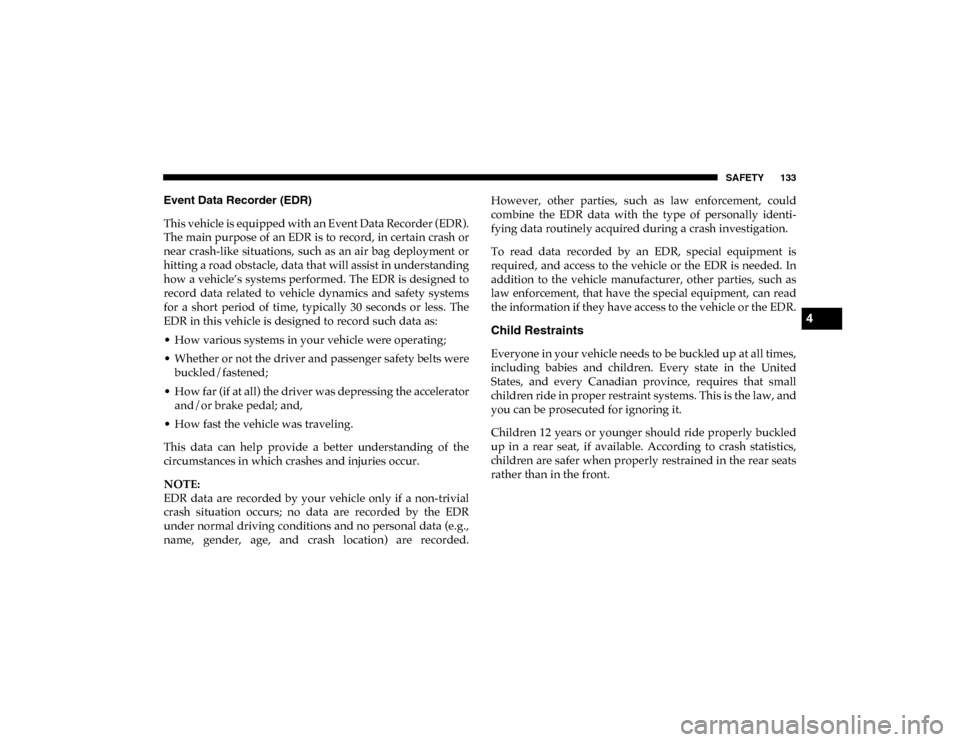
SAFETY 133
Event Data Recorder (EDR)
This vehicle is equipped with an Event Data Recorder (EDR).
The main purpose of an EDR is to record, in certain crash or
near crash-like situations, such as an air bag deployment or
hitting a road obstacle, data that will assist in understanding
how a vehicle’s systems performed. The EDR is designed to
record data related to vehicle dynamics and safety systems
for a short period of time, typically 30 seconds or less. The
EDR in this vehicle is designed to record such data as:
• How various systems in your vehicle were operating;
• Whether or not the driver and passenger safety belts werebuckled/fastened;
• How far (if at all) the driver was depressing the accelerator and/or brake pedal; and,
• How fast the vehicle was traveling.
This data can help provide a better understanding of the
circumstances in which crashes and injuries occur.
NOTE:
EDR data are recorded by your vehicle only if a non-trivial
crash situation occurs; no data are recorded by the EDR
under normal driving conditions and no personal data (e.g.,
name, gender, age, and crash location) are recorded. However, other parties, such as law enforcement, could
combine the EDR data with the type of personally identi
-
fying data routinely acquired during a crash investigation.
To read data recorded by an EDR, special equipment is
required, and access to the vehicle or the EDR is needed. In
addition to the vehicle manufacturer, other parties, such as
law enforcement, that have the special equipment, can read
the information if they have access to the vehicle or the EDR.
Child Restraints
Everyone in your vehicle needs to be buckled up at all times,
including babies and children. Every state in the United
States, and every Canadian province, requires that small
children ride in proper restraint systems. This is the law, and
you can be prosecuted for ignoring it.
Children 12 years or younger should ride properly buckled
up in a rear seat, if available. According to crash statistics,
children are safer when properly restrained in the rear seats
rather than in the front.
4
2020_RAM_PROMASTER_CITY_OM_USA=GUID-7B6A7FCA-79B0-423F-95C5-ED2A949C3D13=1=en=.book Page 133
Page 140 of 350
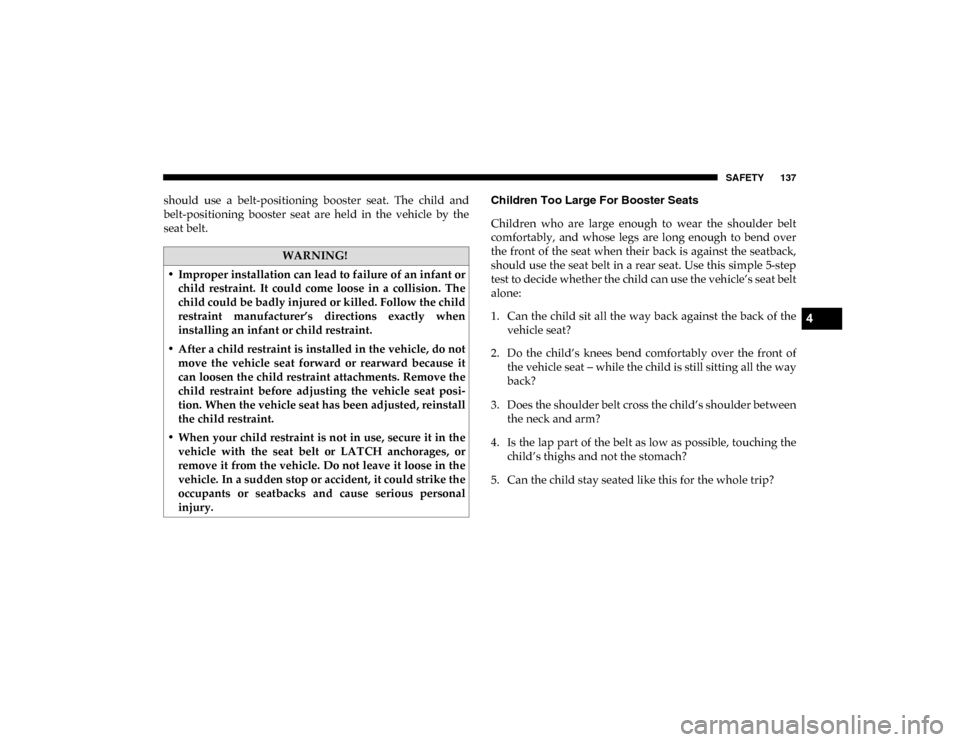
SAFETY 137
should use a belt-positioning booster seat. The child and
belt-positioning booster seat are held in the vehicle by the
seat belt.Children Too Large For Booster Seats
Children who are large enough to wear the shoulder belt
comfortably, and whose legs are long enough to bend over
the front of the seat when their back is against the seatback,
should use the seat belt in a rear seat. Use this simple 5-step
test to decide whether the child can use the vehicle’s seat belt
alone:
1. Can the child sit all the way back against the back of the
vehicle seat?
2. Do the child’s knees bend comfortably over the front of the vehicle seat – while the child is still sitting all the way
back?
3. Does the shoulder belt cross the child’s shoulder between the neck and arm?
4. Is the lap part of the belt as low as possible, touching the child’s thighs and not the stomach?
5. Can the child stay seated like this for the whole trip?
WARNING!
• Improper installation can lead to failure of an infant or child restraint. It could come loose in a collision. The
child could be badly injured or killed. Follow the child
restraint manufacturer’s directions exactly when
installing an infant or child restraint.
• After a child restraint is installed in the vehicle, do not move the vehicle seat forward or rearward because it
can loosen the child restraint attachments. Remove the
child restraint before adjusting the vehicle seat posi -
tion. When the vehicle seat has been adjusted, reinstall
the child restraint.
• When your child restraint is not in use, secure it in the vehicle with the seat belt or LATCH anchorages, or
remove it from the vehicle. Do not leave it loose in the
vehicle. In a sudden stop or accident, it could strike the
occupants or seatbacks and cause serious personal
injury.
4
2020_RAM_PROMASTER_CITY_OM_USA=GUID-7B6A7FCA-79B0-423F-95C5-ED2A949C3D13=1=en=.book Page 137
Page 147 of 350
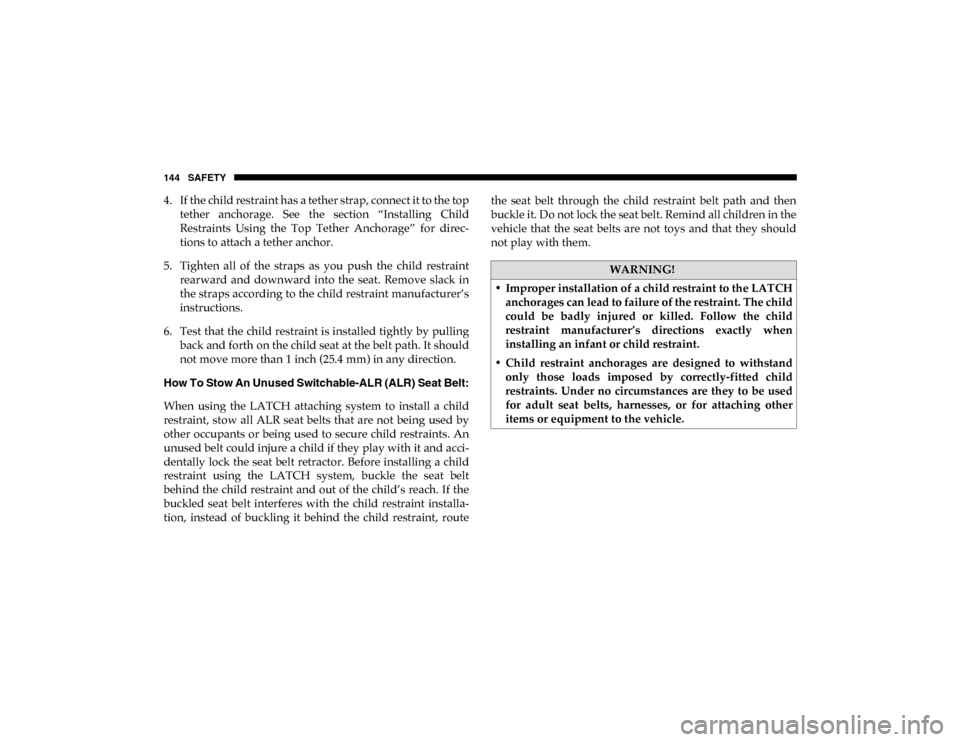
144 SAFETY
4. If the child restraint has a tether strap, connect it to the toptether anchorage. See the section “Installing Child
Restraints Using the Top Tether Anchorage” for direc -
tions to attach a tether anchor.
5. Tighten all of the straps as you push the child restraint rearward and downward into the seat. Remove slack in
the straps according to the child restraint manufacturer’s
instructions.
6. Test that the child restraint is installed tightly by pulling back and forth on the child seat at the belt path. It should
not move more than 1 inch (25.4 mm) in any direction.
How To Stow An Unused Switchable-ALR (ALR) Seat Belt:
When using the LATCH attaching system to install a child
restraint, stow all ALR seat belts that are not being used by
other occupants or being used to secure child restraints. An
unused belt could injure a child if they play with it and acci -
dentally lock the seat belt retractor. Before installing a child
restraint using the LATCH system, buckle the seat belt
behind the child restraint and out of the child’s reach. If the
buckled seat belt interferes with the child restraint installa -
tion, instead of buckling it behind the child restraint, route the seat belt through the child restraint belt path and then
buckle it. Do not lock the seat belt. Remind all children in the
vehicle that the seat belts are not toys and that they should
not play with them.
WARNING!
• Improper installation of a child restraint to the LATCH anchorages can lead to failure of the restraint. The child
could be badly injured or killed. Follow the child
restraint manufacturer’s directions exactly when
installing an infant or child restraint.
• Child restraint anchorages are designed to withstand only those loads imposed by correctly-fitted child
restraints. Under no circumstances are they to be used
for adult seat belts, harnesses, or for attaching other
items or equipment to the vehicle.
2020_RAM_PROMASTER_CITY_OM_USA=GUID-7B6A7FCA-79B0-423F-95C5-ED2A949C3D13=1=en=.book Page 144
Page 148 of 350
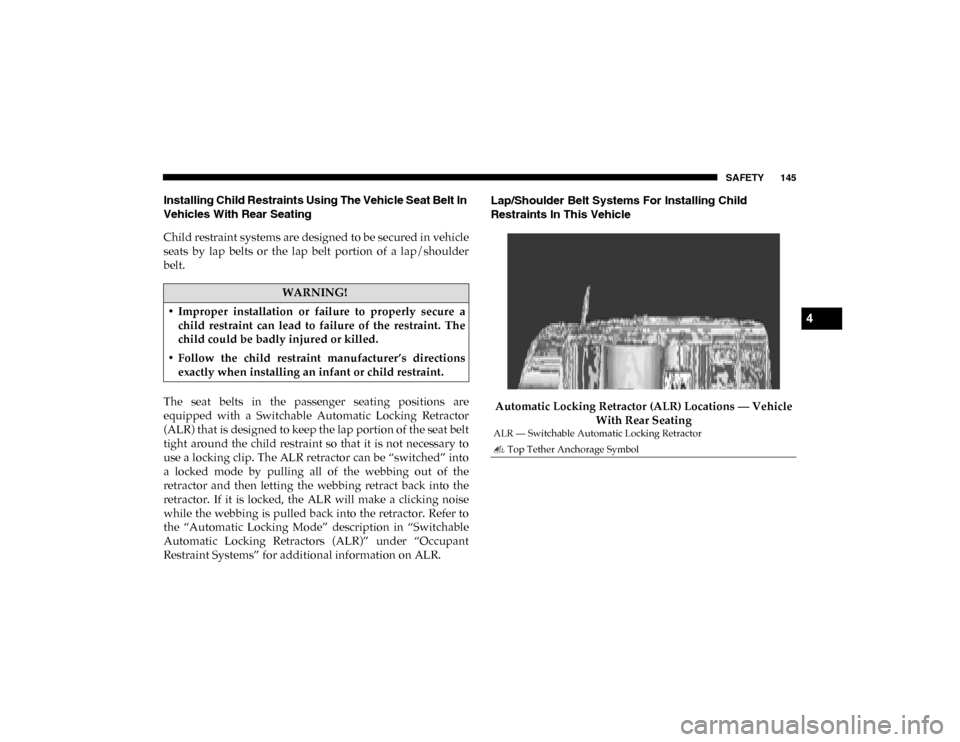
SAFETY 145
Installing Child Restraints Using The Vehicle Seat Belt In
Vehicles With Rear Seating
Child restraint systems are designed to be secured in vehicle
seats by lap belts or the lap belt portion of a lap/shoulder
belt.
The seat belts in the passenger seating positions are
equipped with a Switchable Automatic Locking Retractor
(ALR) that is designed to keep the lap portion of the seat belt
tight around the child restraint so that it is not necessary to
use a locking clip. The ALR retractor can be “switched” into
a locked mode by pulling all of the webbing out of the
retractor and then letting the webbing retract back into the
retractor. If it is locked, the ALR will make a clicking noise
while the webbing is pulled back into the retractor. Refer to
the “Automatic Locking Mode” description in “Switchable
Automatic Locking Retractors (ALR)” under “Occupant
Restraint Systems” for additional information on ALR.Lap/Shoulder Belt Systems For Installing Child
Restraints In This Vehicle
Automatic Locking Retractor (ALR) Locations — Vehicle With Rear Seating
WARNING!
• Improper installation or failure to properly secure a child restraint can lead to failure of the restraint. The
child could be badly injured or killed.
• Follow the child restraint manufacturer’s directions exactly when installing an infant or child restraint.
ALR — Switchable Automatic Locking Retractor
Top Tether Anchorage Symbol
4
2020_RAM_PROMASTER_CITY_OM_USA=GUID-7B6A7FCA-79B0-423F-95C5-ED2A949C3D13=1=en=.book Page 145
Page 150 of 350
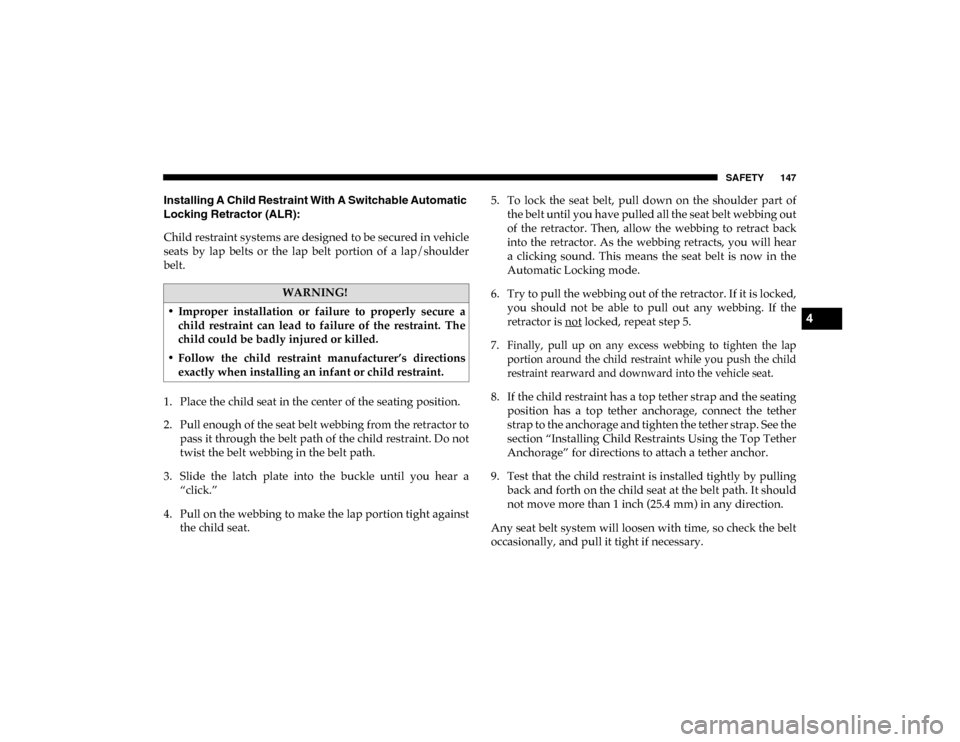
SAFETY 147
Installing A Child Restraint With A Switchable Automatic
Locking Retractor (ALR):
Child restraint systems are designed to be secured in vehicle
seats by lap belts or the lap belt portion of a lap/shoulder
belt.
1. Place the child seat in the center of the seating position.
2. Pull enough of the seat belt webbing from the retractor topass it through the belt path of the child restraint. Do not
twist the belt webbing in the belt path.
3. Slide the latch plate into the buckle until you hear a “click.”
4. Pull on the webbing to make the lap portion tight against the child seat. 5. To lock the seat belt, pull down on the shoulder part of
the belt until you have pulled all the seat belt webbing out
of the retractor. Then, allow the webbing to retract back
into the retractor. As the webbing retracts, you will hear
a clicking sound. This means the seat belt is now in the
Automatic Locking mode.
6. Try to pull the webbing out of the retractor. If it is locked, you should not be able to pull out any webbing. If the
retractor is not
locked, repeat step 5.
7. Finally, pull up on any excess webbing to tighten the lap portion around the child restraint while you push the child
restraint rearward and downward into the vehicle seat.
8. If the child restraint has a top tether strap and the seating position has a top tether anchorage, connect the tether
strap to the anchorage and tighten the tether strap. See the
section “Installing Child Restraints Using the Top Tether
Anchorage” for directions to attach a tether anchor.
9. Test that the child restraint is installed tightly by pulling back and forth on the child seat at the belt path. It should
not move more than 1 inch (25.4 mm) in any direction.
Any seat belt system will loosen with time, so check the belt
occasionally, and pull it tight if necessary.
WARNING!
• Improper installation or failure to properly secure a child restraint can lead to failure of the restraint. The
child could be badly injured or killed.
• Follow the child restraint manufacturer’s directions exactly when installing an infant or child restraint.
4
2020_RAM_PROMASTER_CITY_OM_USA=GUID-7B6A7FCA-79B0-423F-95C5-ED2A949C3D13=1=en=.book Page 147